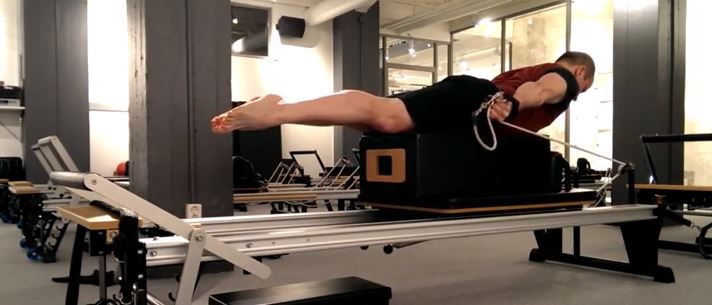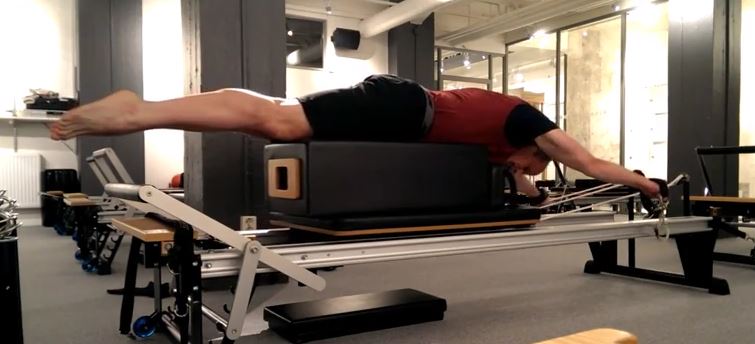Let us talk about arms-pulling-straps, a very well-known exercise on preformed on the Reformer, using the long box. Arms-pulling-straps can easily be mistaken for an arm and shoulder exercise, but in fact it is an activity for the whole body. It is important to remember that while the arms are in action, the legs should be gently engaged and stretched down and away from the center, with a gentle ‘squeeze’ of the inner thighs to accentuate support in the lower abdomen. As for the arm action, the arms need to be very straight as they move, and some people may understandably criticize me for having the client ‘lock’ their elbows. Fair enough, but long arms is what leads to the intended use of the shoulder and upper back, thus I think the importance of straight arms cannot be overstated. One also needs to place meaningful focus on the arms moving from the forward position to the back with a coordinated a fluid transition of the back from flexion to extension. And it is here that the powerhouse support comes into focus…for the back extension has its root far within the powerhouse. As the sensitivity to that mechanism takes hold, then it is easier to have the neck and head in alignment with the rest of the spine, facilitating a gentle lengthening throughout the work.
I love this elegant exercise; it is one of my favorites to do, and to teach because it is a great exercise to convey to my students:
- That every exercise is for the whole body.
- How to use the body in conjunction with tremendous support from the powerhouse, which then enables one to….
- Engage the upper body without undue stress in the neck and shoulders.
And if you can convey some understanding of the above, then you can go into a few more subtle aspects of Pilates such as:
- That the action of the arms actually originates from the center (powerhouse)
- That using the arms/shoulders rigorously while consciously maintaining balance in the whole, but especially neck and shoulders, prepares the person to have this sensitivity in their everyday life, and thus have a similar balance in everyday activities.
If you can get that across to your student, then the quality of life increase that happens with doing Pilates well can take place.
Hurray for arms pulling straps!
In my short experience with Classical Pilates, I was told that arms pulling straps should always be done with one spring. ALWAYS! This immediately struck me as stupid and arbitrary. For example, why would I, a fully trained, strong ex-dancer employ the same spring tension as a small untrained teenage girl? I have asked around about this rule, and come to know of 2 explanations. I will speak to each of them.
Reason 1: Your own weight, plus 1 spring is the correct amount of tension for the exercise.
A short conversation with your local physics professor will soon reveal that this explanation simply will not do, for it assumes that a heavier person will have to exert more force while performing the exercise. However, the person’s weight is supported by the long box on the carriage, which is on wheels. The weight of the heavier person will only add more friction of the wheels rolling on the Reformer tracks, and nothing else. The force required to overcome this extra friction is almost negligible compared to the amount of force required to overcome the resistance of the 1 spring. This means that the amount of force exerted remains independent of the weight of the person. Performing the exercise with one spring for a small teen age girl and a large trained man requires essentially the same amount of force from each.
It is hard to argue with physics.
Reason 2: It is a rule for a reason, and it has always been this way.
This kind of reason I run into a lot in yoga, and less so in Pilates, but it does show up. This is of course no reason at all, it is only an admonishment to follow blindly, especially when ‘the reason’ is said to have come from an authority figure.
Bruce Springsteen – Blind faith in your leaders, or in anything, will get you killed
Rules handed down from authority can give great comfort, for then we need not to go into that treacherous territory of our own judgment and creativity. Rules give answers. Those who question rules are commonly attacked by others who bask in the comfort of blind faith. It does not take too much research to find many examples of atrocity whose roots can be found in blind faith. And we wonder of those who committed crimes ‘how could they do that’? They did it with the same mindset, albeit more intensely, as those who adhere to the one spring rule simply because ‘there is a reason’.
David Suchet – Although I’m a very emotional man, I just can’t have blind faith; I have to find out for myself.
And this is so germane for our community because what Pilates does, if done well, is to make one very robust in all areas. So robust, in fact, that one has the energy and strength to break free of that need for comfort of rules, and to really look for one’s self at the possibilities. This in turn empowers teachers to speak from their very own, open-minded experience – real intelligence and true evolution in action. Yes, baby, that is what I love, and I even think it was a part of Mr. Pilates’ vision.
Thomas Huxley – The improver of natural knowledge absolutely refuses to acknowledge authority, as such. For him, skepticism is the highest of duties; blind faith the one unpardonable sin.
And finally, while I myself do not use the term ‘body-mind-spirit’ (as I wrote in this article), I will do so now when I ask the question – does anyone really believe that blind following is good for the spirit?
Why be open to different spring tensions?
The reason why we should be open to varying spring tension in arms pulling straps is because doing things under different conditions gives feedback to the doer. To perform the exercise with less (or more) spring tension, even temporarily, can give valuable information which leads to a deeper understanding of the task at hand. For example, it happens often that people work with far too much tension in the neck and shoulders, are not engaging the powerhouse, and are muscling their way through it like some body-pump enthusiast, failing to realize more subtle aspects of the work. In a situation like this, I take them down to half a spring, and the results have been very good.
Okay, next week we hear from Andrea with her reasons why the one spring rule is good and helpful, so stay tuned!


